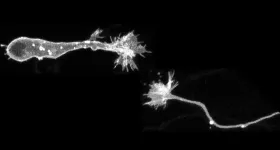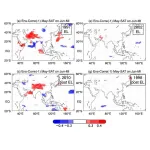(Press-News.org) CAMBRIDGE, MA -- A new study of people who speak many languages has found that there is something special about how the brain processes their native language.
In the brains of these polyglots — people who speak five or more languages — the same language regions light up when they listen to any of the languages that they speak. In general, this network responds more strongly to languages in which the speaker is more proficient, with one notable exception: the speaker’s native language. When listening to one’s native language, language network activity drops off significantly.
The findings suggest there is something unique about the first language one acquires, which allows the brain to process it with minimal effort, the researchers say.
“Something makes it a little bit easier to process — maybe it’s that you’ve spent more time using that language — and you get a dip in activity for the native language compared to other languages that you speak proficiently,” says Evelina Fedorenko, an associate professor of neuroscience at MIT, a member of MIT’s McGovern Institute for Brain Research, and the senior author of the study.
Saima Malik-Moraleda, a graduate student in the Speech and Hearing Bioscience and Technology Program at Harvard University, and Olessia Jouravlev, a former MIT postdoc who is now an associate professor at Carleton University, are the lead authors of the paper, which appears today in the journal Cerebral Cortex.
Many languages, one network
The brain’s language processing network, located primarily in the left hemisphere, includes regions in the frontal and temporal lobes. In a 2021 study, Fedorenko’s lab found that in the brains of polyglots, the language network was less active when listening to their native language than the language networks of people who speak only one language.
In the new study, the researchers wanted to expand on that finding and explore what happens in the brains of polyglots as they listen to languages in which they have varying levels of proficiency. Studying polyglots can help researchers learn more about the functions of the language network, and how languages learned later in life might be represented differently than a native language or languages.
“With polyglots, you can do all of the comparisons within one person. You have languages that vary along a continuum, and you can try to see how the brain modulates responses as a function of proficiency,” Fedorenko says.
For the study, the researchers recruited 34 polyglots, each of whom had at least some degree of proficiency in five or more languages but were not bilingual or multilingual from infancy. Sixteen of the participants spoke 10 or more languages, including one who spoke 54 languages with at least some proficiency.
Each participant was scanned with functional magnetic resonance imaging (fMRI) as they listened to passages read in eight different languages. These included their native language, a language they were highly proficient in, a language they were moderately proficient in, and a language in which they described themselves as having low proficiency.
They were also scanned while listening to four languages they didn’t speak at all. Two of these were languages from the same family (such as Romance languages) as a language they could speak, and two were languages completely unrelated to any languages they spoke.
The passages used for the study came from two different sources, which the researchers had previously developed for other language studies. One was a set of Bible stories recorded in many different languages, and the other consisted of passages from “Alice in Wonderland” translated into many languages.
Brain scans revealed that the language network lit up the most when participants listened to languages in which they were the most proficient. However, that did not hold true for the participants’ native languages, which activated the language network much less than non-native languages in which they had similar proficiency. This suggests that people are so proficient in their native language that the language network doesn’t need to work very hard to interpret it.
“As you increase proficiency, you can engage linguistic computations to a greater extent, so you get these progressively stronger responses. But then if you compare a really high-proficiency language and a native language, it may be that the native language is just a little bit easier, possibly because you've had more experience with it,” Fedorenko says.
Brain engagement
The researchers saw a similar phenomenon when polyglots listened to languages that they don’t speak: Their language network was more engaged when listening to languages related to a language that they could understand, than compared to listening to completely unfamiliar languages.
“Here we’re getting a hint that the response in the language network scales up with how much you understand from the input,” Malik-Moraleda says. “We didn’t quantify the level of understanding here, but in the future we’re planning to evaluate how much people are truly understanding the passages that they're listening to, and then see how that relates to the activation.”
The researchers also found that a brain network known as the multiple demand network, which turns on whenever the brain is performing a cognitively demanding task, also becomes activated when listening to languages other than one’s native language.
“What we’re seeing here is that the language regions are engaged when we process all these languages, and then there’s this other network that comes in for non-native languages to help you out because it’s a harder task,” Malik-Moraleda says.
In this study, most of the polyglots began studying their non-native languages as teenagers or adults, but in future work, the researchers hope to study people who learned multiple languages from a very young age. They also plan to study people who learned one language from infancy but moved to the United States at a very young age and began speaking English as their dominant language, while becoming less proficient in their native language, to help disentangle the effects of proficiency versus age of acquisition on brain responses.
###
The research was funded by the McGovern Institute for Brain Research, MIT’s Department of Brain and Cognitive Sciences, and the Simons Center for the Social Brain.
END
For people who speak many languages, there’s something special about their native tongue
An MIT study finds the brains of polyglots expend comparatively little effort when processing their native language.
2024-03-11
ELSE PRESS RELEASES FROM THIS DATE:
Blood-based marker developed to identify sleep deprivation
2024-03-09
A blood test that can accurately detect when someone has not slept for 24 hours has been developed by experts at Monash University, in Australia, and the University of Birmingham, in the UK.
This level of sleep deprivation increases the risk of serious injury or fatality in safety critical situations.
Published in Science Advances, the biomarker used a combination of markers found in the blood of healthy volunteers. Together, these markers accurately predicted when the study volunteers had been awake for more than 24 hours under controlled laboratory conditions.
The ...
Paclitaxel-coated balloon vs uncoated balloon for coronary in-stent restenosis
2024-03-09
About The Study: Among patients undergoing coronary angioplasty for in-stent restenosis, a paclitaxel-coated balloon was superior to an uncoated balloon with respect to the composite end point of target lesion failure in this multicenter randomized trial that included 600 patients. Paclitaxel-coated balloons are an effective treatment option for patients with coronary in-stent restenosis.
Authors: Robert W. Yeh, M.D., M.Sc., of Beth Israel Deaconess Medical Center in Boston, is ...
Deciphering the tip of migrating neurons: Discovery of growth cone in migrating neurons involved in promoting neuronal migration and regeneration in the brain after injury
2024-03-09
The structure and functions of the tip of migrating neurons remain elusive. Here, a research group led by Kazunobu Sawamoto, Professor at Nagoya City University and National Institute for Physiological Sciences, and by Chikako Nakajima and Masato Sawada, staff scientists in his laboratory, has found that the PTPσ-expressing growth cone senses the extracellular matrix and drives neuronal migration in the injured brain, leading to functional recovery.
Neural stem cells are present in the postnatal mammalian brain and produce new neurons. New neurons ...
Land or sea? Scientists reveal effect of land conditions on Asian monsoon climate
2024-03-09
Tokyo, Japan – Researchers from Tokyo Metropolitan University have used numerical simulations to show how conditions on land impact weather during Asian summer monsoons. Focusing on the Tibetan plateau, they studied how varied land conditions combined with fixed maritime conditions illuminate the specific effects of the land on the weather. They found that the significance of land-atmosphere coupling varies greatly from year to year, with unexpectedly low dependence on maritime phenomena like El Niño.
Asian monsoon systems impact some of the most highly populated areas of the world, affecting enormous swathes of Asia and ...
What heat can tell us about battery chemistry: using the Peltier effect to study lithium-ion cells
2024-03-08
Batteries are usually studied via electrical properties like voltage and current, but new research suggests that observing how heat flows in conjunction with electricity can give important insights into battery chemistry.
A team of researchers at the University of Illinois Urbana-Champaign has demonstrated how to study chemical properties of lithium-ion battery cells by exploiting the Peltier effect, in which electrical current causes a system to draw heat. Reported in the journal Physical Chemistry Chemical Physics, this ...
NRL participates in international campaign investigating polar low phenomena
2024-03-08
WASHINGTON – U.S. Naval Research Laboratory (NRL) research meteorologist James Doyle, Ph.D., joins an international team of scientists to investigate meteorological processes associated with Arctic cold air outbreaks.
From late February through early April, the 45-day international field campaign CAESAR, short for Cold-Air outbreak Experiment in the Sub-Arctic Region, is focused on cold-air outbreaks that occur as cold Arctic air flows-out over warmer open waters between northern Norway and ...
Are mountains carbon dioxide sources or sinks? New study finds they can be both
2024-03-08
There’s been a long-running debate in Earth sciences over whether mountains are a source of carbon dioxide or if they remove carbon dioxide from the atmosphere through mineral weathering. A new study has found that mountains can be sources or sinks and has identified the tipping point at which they switch from one to the other.
The study — by Ludwig Maximilian University of Munich, Colorado State University and the German Research Centre for Geosciences — found that many mountains exist on a spectrum of removing or releasing carbon, and erosion rates determine the impact of mountains ...
Child care costs, availability keeping New York parents at home, poll finds
2024-03-08
BUFFALO, N.Y. - Two out of five New Yorkers with children who participated in a recent poll report that a member of their household opts not to work, mostly because child care is too expensive, while child care workers earn among the lowest wages in the state, according to a report released March 8 by the Cornell School of Industrial and Labor Relations Buffalo Co-Lab.
Continuing a multiyear effort with collaborators to determine the “true” cost of child care, “The Status of Child Care in New York State” finds that recent increases in state subsidies helped stabilize ...
Blood pressure control in veterans declined during the COVID-19 pandemic
2024-03-08
A multi-institution team led by researchers at the White River Junction VA Medical Center in Vermont found that Veterans’ blood pressure control worsened due to disrupted care during the COVID-19 pandemic. The findings were published in the journal Medical Care.
The researchers followed a group of nearly 1.65 million Veterans who received their care at VA and who had high blood pressure (hypertension) during two periods—before the pandemic and during the pandemic. In Veterans with controlled blood pressure, researchers found a 7% decline in control during the pandemic compared ...
Lighting the way to noninvasive blood glucose monitoring using portable devices
2024-03-08
Diabetes is a very prevalent disease that, unfortunately, still has no treatment. People with diabetes need to monitor their blood glucose levels (BGLs) regularly and administer insulin to keep them in check. In almost all cases, BGL measurements involve drawing blood from a fingertip through a finger prick. Since this procedure is painful, less invasive alternatives that leverage modern electronics are being actively researched worldwide.
Thus far, several methods to measure BGL have been proposed; using infrared light is a prominent example, and mid-infrared light-based devices have shown reasonable performance. However, the required sources, ...
LAST 30 PRESS RELEASES:
Valvular heart disease is common in cancer patients but interventions improve survival
When socially responsible investing backfires
Cuffless blood pressure technologies in wearable devices show promise to transform care
AI-based tool predicts future cardiovascular events in patients with angina
Researchers map how the cerebellum builds its connections with the rest of the brain during early development
Routine scans could detect early prostate radiotherapy changes
Fairness in AI: Study shows central role of human decision-making
Pandemic ‘beneath the surface’ has been quietly wiping out sea urchins around the world
Tea linked to stronger bones in older women, while coffee may pose risks
School feeding programs lead to modest but meaningful results
Researchers develop AI Tool to identify undiagnosed Alzheimer's cases while reducing disparities
Seaweed based carbon catalyst offers metal free solution for removing antibiotics from water
Simple organic additive supercharges UV treatment of “forever chemical” PFOA
£13m NHS bill for ‘mismanagement’ of menstrual bleeds
The Lancet Psychiatry: Slow tapering plus therapy most effective strategy for stopping antidepressants, finds major meta-analysis
Body image issues in adolescence linked to depression in adulthood
Child sexual exploitation and abuse online surges amid rapid tech change; new tool for preventing abuse unveiled for path forward
Dragon-slaying saints performed green-fingered medieval miracles, new study reveals
New research identifies shared genetic factors between addiction and educational attainment
Epilepsy can lead to earlier deaths in people with intellectual disabilities, study shows
Global study suggests the underlying problems of ECT patients are often ignored
Mapping ‘dark’ regions of the genome illuminates how cells respond to their environment
ECOG-ACRIN and Caris Life Sciences unveil first findings from a multi-year collaboration to advance AI-powered multimodal tools for breast cancer recurrence risk stratification
Satellite data helps UNM researchers map massive rupture of 2025 Myanmar earthquake
Twisting Spins: Florida State University researchers explore chemical boundaries to create new magnetic material
Mayo Clinic researchers find new hope for toughest myeloma through off-the-shelf immunotherapy
Cell-free DNA Could Detect Adverse Events from Immunotherapy
American College of Cardiology announces Fuster Prevention Forum
AAN issues new guideline for the management of functional seizures
Could GLP-1 drugs affect risk of epilepsy for people with diabetes?
[Press-News.org] For people who speak many languages, there’s something special about their native tongueAn MIT study finds the brains of polyglots expend comparatively little effort when processing their native language.




